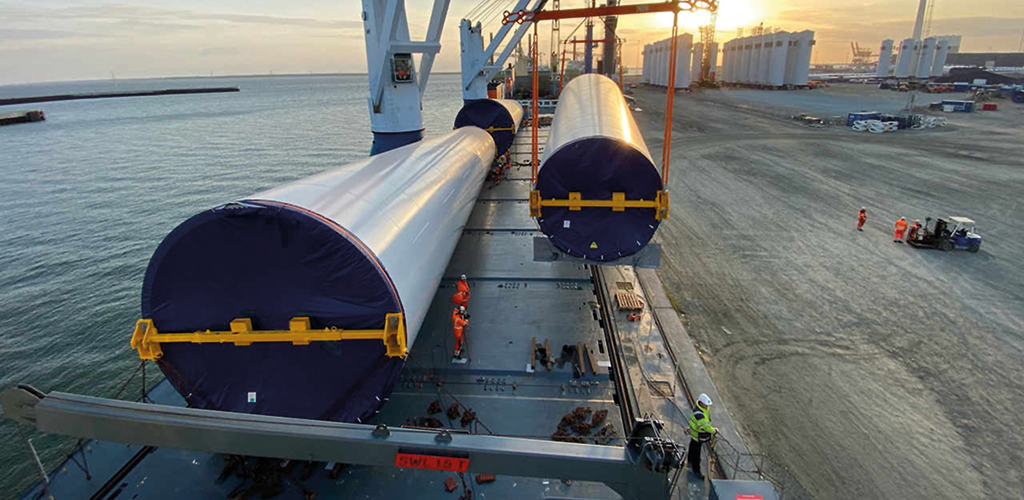Lindahl Leads Maersk’s Special Cargo Transformation

By Michael King
 A.P. Moller-profits generated by its container and freight divisions over the past two years are helping the company build out its global logistics footprint, and enhancing its out-of-gauge service options in the process, according to Henrik Lindahl, special cargo logistics lead in A.P. Moller - Maersk’s (APMM) Special Cargo Solutions division.
A.P. Moller-profits generated by its container and freight divisions over the past two years are helping the company build out its global logistics footprint, and enhancing its out-of-gauge service options in the process, according to Henrik Lindahl, special cargo logistics lead in A.P. Moller - Maersk’s (APMM) Special Cargo Solutions division.
The container-shipping sector was buffeted by an unprecedented set of disruptive events throughout the pandemic. As slots on ships became a precious commodity, freight rates reached record levels and APMM and other carriers racked up historical profits.
While the space shortage squeezed the options available to Lindahl’s team on the decks and in the holds of the Maersk fleet, it also created new opportunities. First and foremost, he tells Breakbulk, it encouraged shippers to approach asset owners directly for space.
“We had lots of BCOs (beneficial cargo owners) coming direct to us because of the situation of limited space, limited equipment availability and so forth,” Lindahl said. “A lot of them had problems. Projects need time-definite solutions. Cargo needs to be at sites or delivered to, for example, energy companies or state-owned projects. If they don’t deliver on time they are in trouble with high penalties. So, the market sought solutions direct with asset owners. That was a game-changer for us. It was suddenly about taking over a part [of the supply chain] that the forwarders used to do, meaning the onshore, the inland part, the origin and the destination.”
Maersk’s Transformation
While this was a new challenge for Lindahl’s team, it was one planned for by APMM for many years. Indeed, the end-to-end opportunities thrust upon Maersk’s Special Cargo Solutions division during the pandemic were first embraced by APMM as part of the conglomerate’s strategic rethink in 2016. Back then, APMM owned multiple businesses but was essentially operating in two markets that offered very little synergy – upstream oil & gas and container shipping. It was prospering in neither as both oil prices and ocean shipping freight rates were bearish, putting profits and market capitalization into retreat.
New management headed by Maersk veteran Søren Skou as CEO came up with a new strategy. In future, it was decided, APMM would move beyond offering port-to-port commoditized services and instead meet shippers’ global requirements door-to-door across modes. In essence, the plan was to deal directly with shippers and to hack into the some of the huge and consistent profits being generated by global integrators, forwarders and 3PLs.
The strategy has been rocket-fueled by the huge profits the company has racked up during the pandemic which have enabled a string of investments to build out its forwarding, warehousing and logistics footprint worldwide. This transformation has created a far more expansive global logistics footprint covering services far beyond the port. In turn, this has created new possibilities for APMM’s project specialists.
“We have a splendid set up for integrated logistics on the container side, but it was quite new for us on the out-of-gauge side,” Lindahl explained. End-to-end logistics in some parts of the world like China and the U.S. were “no problem,” he said. Elsewhere the carrier partnered with a range of new vendors to build out its procurement operations and end-to-end out-of-gauge solutions footprint.
Lindahl’s experience in project forwarding makes him a perfect fit for the new strategy. Prior to joining Maersk in 2020, he served as industrial project manager for Kuehne+Nagel in Sweden, global director energy industrial projects at GEODIS and also held senior positions at Agility.
Project Forwarders Still Valued
Lindahl insisted that despite the new strategy, freight forwarders were, and would remain, important customers of Maersk’s projects business.
Also, he added, many of the more recent logistics and storage acquisitions by APMM did not have a huge direct impact on the company’s projects division.
“They are mainly for logistics solutions or 4PL solutions, or for air freight and some domestic U.S., so they’re not specific to out-of-gauge,” he said. “But it has forced us in a direction where we need to find the right resources in countries that we can work with on support activities, so we’re not considered an ocean carrier but as an integrator.”
Lindahl said customers had pushed the issue. “They’ve come to us and said, ‘We want to do this with you,” so we’ve needed to find a solution, whether it’s partnering up with new vendors or developing old relationships a bit further. But there are a lot of countries out there and there’s a long way to go to have an outstanding out-of-gauge performance end-to-end. It’s a work in progress. But there is demand for end-to-end services, especially now when space is tight and asset owners have certain capabilities.
“The foundation is there; we need to build on it as an integrator.”
Container lines have been criticized throughout the pandemic for schedule reliability levels that have barely surpassed 50 percent. Maersk has tended to be one of the better performers, and Lindahl said the Maersk name tended to be the trump card with customers, outweighing the scheduling and port congestion issues that have afflicted the entire sector.
This has helped APMM keep its out-of-gauge volumes at consistent levels at around, “125,000 moves on special equipment, open tops, flat racks and as breakbulk per annum.”
He added: “It’s a significant number, but it’s still quite a small number overall of what we do in terms of unitized shipping.”
He said space availability and storage options across the Maersk fleet – the second-largest box fleet in the world after MSC and totaling 733 vessels with capacity for 4.255 million 20-foot-equivalent units, according to Alphaliner – currently varied depending on trade, space availability and box rates. “It’s not a competition within Maersk, but we need to have balance in terms of pricing and space usage,” he said.
Disruptions to Continue
He expects pandemic-linked disruption, equipment dislocations and port congestion to continue to be an issue in the short and medium term, especially until China, “a huge market,” ends its strict Covid lockdown policy that particularly impacted cargo availability at the key breakbulk port of Shanghai in the second quarter.
Longer-term, Lindahl expects Maersk’s greatest opportunities to materialize as the group builds on its move towards offering integrated services across its cargo portfolio, including project logistics. “It’s difficult to look in the crystal ball, but what we know is that the heavy-lift shipping market has constraints in that there are no newbuild vessels coming in the next few years. Then we have other multipurpose vessels such as roll-on, roll-off vessels which are struggling now. But when that sector kicks up, there will be less space for breakbulk and oversized cargo.”
This would continue to create openings for carriers in high demand sectors. “The renewable industry is the most growing breakbulk and out-of-gauge related vertical with a lot of upcoming projects globally,” he said. “With the constraints with windmills and their blades growing bigger, the heavy-lift carriers will [find this difficult to cater for]. This might open a demand for new solutions for the industry where container carriers might have an opportunity to play a larger role in the future.
“If we see lower demand for containers, we’ll have more space for breakbulk and out-of-gauge cargo, so a lot depends on that.
“In three or four years’ time, we might see a different setup where container carriers could actually deal more with breakbulk, but it depends on how much space we have on the vessel and on the port capacities,” Lindahl said.
Michael King is a multi-award winning journalist as well as a shipping and logistics consultant.
Image credit: Martin Bencher Group/Maersk
